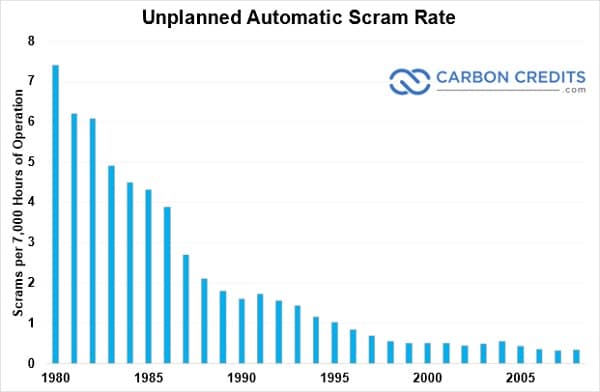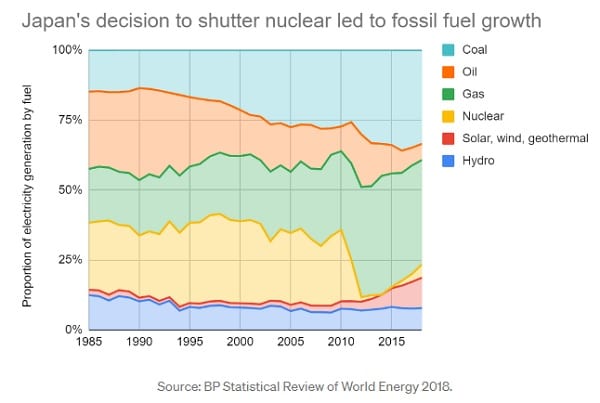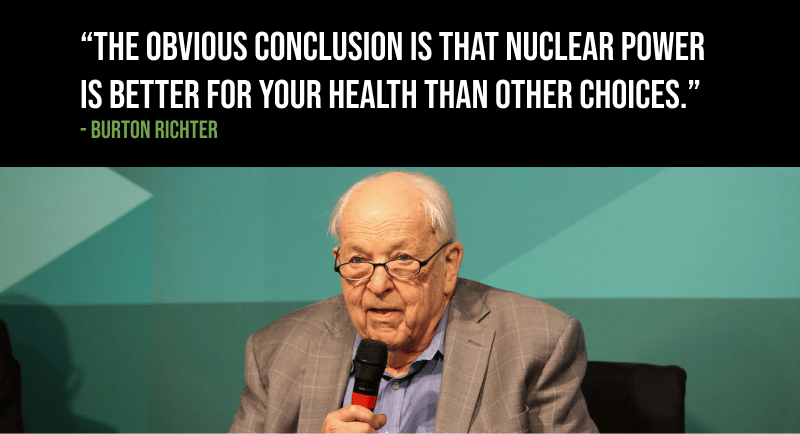Fukushima is the BEST Possible Advertisement for Nuclear Power and its Safety.
About a decade ago, the Union of Concerned Scientists broadcasted an urgent request to U.S. citizens.
They were to write their governors and congress people to demand one thing: improved nuclear safety.
Sounds like a noble pursuit, in theory.
Except that in all of U.S. history…
The recorded number of deaths due to nuclear power is zero.
In fact, nuclear is the safest industry in the entire United States. Working in a nuclear plant is safer than working in a library.
That’s not particularly easy to improve on.
Yet there remains a widespread misconception that nuclear plants are ticking time bombs, just waiting to level an entire city.
Nothing could be further from the truth.
Large-scale nuclear accidents generally involve a nuclear meltdown, which safety is simply due to damage to a nuclear reactor core from overheating.
Two really improbable things have to happen for a meltdown to occur:
- A loss of coolant or coolant pressure to the core, allowing it to heat up.
- A complete failure of both Emergency Core Cooling Systems (ECCS).
In the nearly 20,000 years of combined nuclear operations, there have only been three core meltdowns.
When a meltdown occurs, the danger is not from the core itself. No, it’s not going to melt all the way through to China.
The real danger is from radioactive particles escaping from the reactor.
Fortunately, the release of radioactive matter is generally reduced by the nuclear infrastructure that remains after the meltdown. Except, of course, if the infrastructure that should be there – isn’t.
That’s exactly what happened at the most famous (and worst) nuclear meltdown in history: Chernobyl.
A Rocket without a Windshield
In early 1986, inexperienced personnel attempted an experiment at the Chernobyl nuclear plant in Ukraine.
The plant itself was a particularly cheap, shoddy design.
All other reactor types have a crucial containment dome. It’s a massive, thick steel-and-concrete “lid” that keeps radioactive material inside the nuclear plant if anything goes wrong.
Not having one is like building a rocket that doesn’t have seatbelts, or a windshield.
The perfect combination of untrained personnel, shoddy design, and deliberate violation of safety rules meant that the nuclear experiment went very, very wrong.
The meltdown it triggered caused a chain of explosions—then a massive fire. The fire spewed at least five percent of the reactor core into the surrounding countryside.
It was the largest uncontrolled civilian release of radioactive material in history.
Unlike the nuclear plant, the Soviet Union kept a tight lid on what was happening.
It wasn’t until nuclear workers all the way in Sweden identified high levels of radiation that the Soviet Union was forced to admit the accident had happened.
By then, ten days had passed.
- By every measure, it was the worst possible handling of a nuclear accident.
While what happened was horrible, the official number of deaths directly attributed to the accident is about thirty.
But what about radiation exposure for people near the plant?
More than 200,000 “liquidators,” Soviet citizens, helped with recovery and cleanup of the accident site.
Those who were exposed to 100 millisieverts of radiation—the average for a Chernobyl liquidator—saw their mortality risk increase by 0.4 percent.
If you live with someone who smokes cigarettes, you increase your mortality risk by 1.7 percent.
Even today, the people living around Chernobyl get about as much radiation exposure as people in Colorado, where there’s low-level radiation from granite.
“Where Probability Says We Shouldn’t Be”
A quarter-century after Chernobyl, an 8.9 earthquake struck off the coast of Japan, shifting the entire country a dozen feet east.
Many Japanese nuclear plants had only been built to handle an earthquake with only one-fifth of that magnitude.
Yet none of the eleven reactors in the region suffered any damage.
And in Fukushima, Japan, everything functioned perfectly as planned. Systems detected the earthquake and shut down the reactors. When the power went out, diesel generators kicked in to keep the cores cool.
Soon after the earthquake, a forty-two-foot wave slammed into the coast of Japan. It swept over the sea wall in front of Daiichi, killing the emergency generators… and the backup generators.
A second tsunami hit eight minutes later.
Fortunately, the battery-powered backup of backup generators at Fukushima kicked in, and the cores remained cool—all according to plan.
Eventually, they also failed, resulting in the first and only triple nuclear meltdown in history: All three cores rapidly overheated.
Due to the containment domes, fallout from the accident remained limited.
- There were no reported deaths or cases of radiation sickness in the immediate aftermath of Fukushima.
And of the more than 200 workers who continued to mitigate damages on the site, not a single one died from radiation.
Overall, the loss of life expectancy in the town most affected by Fukushima… was less than that experienced by a London resident from air pollution.
To Sum It All Up…
A crumbling, outdated nuclear plant with poor safety features was hit by the fourth-largest recorded earthquake, then a forty-foot wall of water.
- The electricity supply
- The cooling system stopped functioning.
- The reactors melted down and exploded.
And it killed fewer people than operations at an average coal plant does every single year—when everything goes according to plan.
Fukushima is the best possible advertisement for nuclear power.
Scrams Go Away
The only civilian nuclear meltdown on U.S. soil was at Three Mile Island in Pennsylvania in early 1979. The ECCS was turned off, which led to a partial melting of the core—almost no radioactive material escaped.
While the accident destroyed a billion-dollar reactor, it did not harm people nearby, either during the incident or in the aftermath.
- Total number of deaths from Three Mile Island: zero.
More than a dozen studies conducted since the accident have shown that the amount of radiation released was too small to even measure the health effects.
But just to be safe, the Nuclear Regulatory Commission (NRC) quickly established the Institute of Nuclear Power Operations (INPO). Its job was to help provide training for nuclear plant operators.
The efforts of the INPO have steadily made nuclear energy safer and more reliable for the past forty years.
One of the best measures of nuclear safety is called a “scram.” A scram is an automated shutdown that occurs if necessary to prevent damage to the core.
Control rods are inserted into the core, causing all nuclear reactions to stop.
A scram takes a total of about three seconds.
In 1985, there were 530 scrams in U.S. nuclear reactors.
By 2021, there were only 37—a 93 percent decrease.
Nuclear By Any Other Name
But that’s not important. Because the question is not whether nuclear reactors have a perfect safety record.
Like every source of energy, nuclear is dangerous, and it can cause injury or death.
But are other sources of energy safer?
When Japan halted nuclear production after Fukushima, guess what replaced it.
Not renewables.
Mostly coal and gas.
In two years, Japan started eight new coal-fired power plants, with plans for the biggest coal-power expansion in any developed nation.
Nobel Prize physicist Burton Richter estimated t he years of life lost due to energy sources in Japan.
For nuclear—including the losses attributed to the Fukushima accident—it’s 30 years per TWh.
For coal? 142.
About 20,000 premature deaths are expected over the seventy years following Chernobyl. Compare that to the estimated number of deaths each year from fossil fuel pollution, as identified by Harvard researchers: 8 million.
- Burning fossil fuels creates another Chernobyl—every single day ad. space
The fact is that even first-generation nuclear reactors are an order of magnitude safer than every other fuel source.
Americans will write their congress people, certainly.
But they’ll be begging for nuclear.




